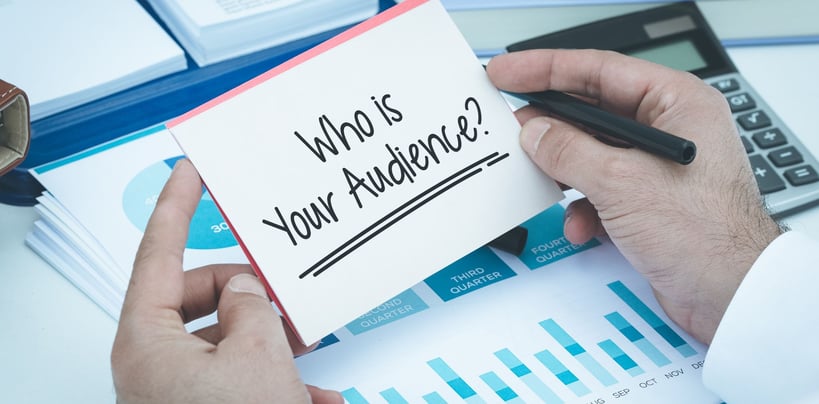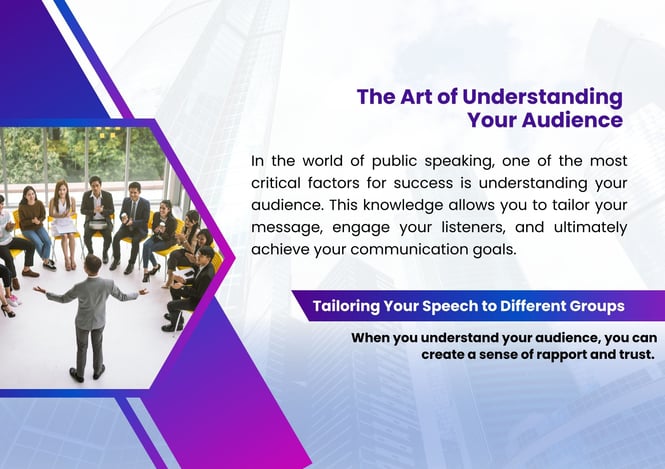Understanding Your Audience: Engage Listeners
In public speaking, one of the most critical factors for success is understanding your audience. This knowledge allows you to tailor your message, engage your listeners, and ultimately achieve your...
Understanding Your Audience: How to Tailor Your Speech
Introduction:
One of the most critical factors for success in public speaking is understanding your audience. This knowledge allows you to tailor your message, engage your listeners, and ultimately achieve your communication goals. Even the most well-prepared presentation can fall flat without a deep understanding of who you are speaking to. By analyzing your audience, you can create a connection that resonates, ensuring that your message is heard, remembered, and acted upon. In this comprehensive guide, we will explore the importance of audience understanding, methods for analyzing your audience, and strategies for adapting your presentation to maximize impact.
Why Understanding Your Audience is Crucial
The Impact on Message Delivery
Understanding your audience fundamentally enhances how you deliver your message. Tailoring your speech to fit the audience’s needs, interests, and level of understanding can transform a mundane presentation into a captivating one. For example, speaking to a group of industry experts allows for the use of jargon and in-depth analysis, while addressing a general audience necessitates simplifying complex concepts. When your content aligns with what the audience expects and needs, it increases clarity, relevance, and persuasiveness, making your presentation far more effective.
Building Connection and Trust
Building a connection with your audience is essential for effective communication. When you understand your audience, you can create a sense of rapport and trust. This connection can be established by showing empathy, sharing relevant personal anecdotes, or addressing common concerns and interests. For instance, a speaker who acknowledges the audience’s challenges and speaks to their specific experiences is more likely to gain their trust and engagement. Trust is the foundation of a compelling speech—it makes the audience more receptive to your message and more likely to act on it.
Enhancing Engagement and Retention
Audience engagement is a key indicator of a successful presentation. When you understand your audience, you can employ strategies that hold their attention and ensure they retain the information. Techniques such as asking questions, incorporating interactive elements, and using relatable examples can significantly boost engagement. For example, a speaker who frequently interacts with the audience through polls or Q&A sessions can maintain a higher level of interest and participation. Engaged audiences are more attentive and more likely to remember and internalize the presented information.
Understanding your audience is not a one-size-fits-all approach; it requires careful consideration and adaptation. However, the benefits—enhanced message delivery, stronger connections, and increased engagement—are well worth the effort.
Steps to Understanding Your Audience
Pre-Presentation Research
Effective audience analysis begins long before you step onto the stage. Pre-presentation research is crucial for gathering the necessary information to tailor your message appropriately. Here are some strategies for conducting thorough pre-presentation research:
Event Organizers: Engage with event organizers to understand the audience profile. They can provide insights into the attendees’ backgrounds, expectations, and interests.
Previous Presentations: Review past presentations given to the same or similar audiences. This can provide clues about what resonated well and what didn’t.
Online Presence: Explore the audience's online presence. This includes social media profiles, company websites, and professional networks like LinkedIn. Understanding their online behavior can offer valuable insights into their interests and professional context.
Demographic Analysis
Demographic analysis involves examining the basic characteristics of your audience. This includes:
Age: Different age groups have varying perspectives and preferences. Tailor your language, examples, and references to match the age demographic of your audience.
Gender: Be mindful of gender inclusivity in your speech. Ensure that examples, anecdotes, and language are balanced and non-discriminatory.
Education Level: Knowing the audience’s education level helps in adjusting the complexity of your content. For a highly educated audience, you might include more sophisticated concepts and jargon.
Cultural Background: Cultural norms and values can significantly influence how your message is received. Understanding cultural differences can help avoid miscommunication and enhance relatability.
Psychographic Analysis
Psychographic analysis goes beyond demographics to explore the psychological attributes of your audience. This includes:
Values and Beliefs: Understanding the core values and beliefs of your audience helps in aligning your message with what they find important.
Interests and Hobbies: Incorporating references to common interests can make your presentation more engaging and relatable.
Lifestyles: Recognizing the lifestyle preferences of your audience can guide the tone and content of your message. For example, a tech-savvy audience might appreciate references to the latest gadgets or software.
Contextual Analysis
The context of the event also plays a crucial role in shaping your presentation. Consider the following:
Event Purpose: Understand the primary goal of the event. Is it educational, motivational, or informational? Align your presentation with the event’s objectives.
Venue: The setting can influence the formality and style of your presentation. A corporate boardroom might require a more formal approach compared to an informal community hall.
Timing: Be aware of your presentation’s timing within the event schedule. Presenting after a long session might require more engaging techniques to re-energize the audience.
By thoroughly analyzing these aspects, you can develop a deep understanding of your audience, enabling you to craft a presentation that is both relevant and compelling.
Tools and Techniques for Audience Analysis
Surveys and Questionnaires
Surveys and questionnaires are effective tools for gathering detailed information about your audience before the presentation. Here’s how to use them effectively:
Designing Surveys: Create concise, focused surveys that ask relevant questions about your audience’s background, interests, and expectations. Use a mix of open-ended and multiple-choice questions to get both qualitative and quantitative data.
Distribution: Distribute surveys through email, social media, or event registration pages. Ensure you provide enough time for responses and follow-up if necessary.
Analyzing Results: Review the responses to identify common themes and insights. Use this information to tailor your content and approach to match the audience’s needs and preferences.
Social Media and Online Research
Social media platforms and online research can provide valuable insights into your audience’s interests and behaviors:
Social Media Analysis: Analyze your audience’s activity on LinkedIn, Twitter, and Facebook platforms. Look for posts, comments, and shared content to understand their interests and concerns.
Online Communities: Join relevant online communities and forums where your audience is active. Participate in discussions to gain firsthand insights into their thoughts and opinions.
Competitor Analysis: Review competitors' or similar speakers' content and engagement strategies to see what resonates with their audience. This can offer clues on how to approach your own presentation.
Direct Engagement
Engaging directly with potential audience members can provide deeper insights and build rapport before your presentation:
Interviews: Conduct one-on-one or small group interviews with representatives of your audience. Ask about their challenges, expectations, and preferences related to the presentation topic.
Focus Groups: Organize focus groups to discuss specific aspects of your presentation. This allows for in-depth feedback and discussion, providing nuanced insights.
Pre-Event Meetings: Attend pre-event networking sessions or meet-and-greet opportunities to interact with attendees. Use these interactions to gather informal feedback and gauge audience expectations.
Analytics and Data Tools
Using data analytics tools can help analyze audience behavior and preferences:
Google Analytics: If you have access to a website or event page, use Google Analytics to track visitor demographics, interests, and behaviors. This data can inform your presentation strategy.
Audience Analysis Tools: Audiense and SparkToro can provide detailed audience insights, including demographics, interests, and online behavior patterns.
Feedback Platforms: Use SurveyMonkey or Typeform to collect and analyze audience feedback. These platforms offer robust analytics features to help you understand and act on the data collected.
By leveraging these tools and techniques, you can comprehensively understand your audience, enabling you to tailor your presentation to effectively meet their needs and expectations.
Adapting Your Presentation Based on Audience Analysis
Customizing Content
Tailoring your content to the specific needs and interests of your audience is crucial for delivering a memorable presentation. Here are some strategies:
Relevance: Ensure your content addresses the audience’s concerns and interests identified during your analysis. For example, if presenting to a group of marketing professionals, focus on case studies and strategies relevant to their field.
Depth of Information: Adjust the complexity of your content based on the audience’s knowledge level. For a technical audience, dive into detailed explanations and advanced concepts. For a general audience, simplify complex ideas and focus on the big picture.
Examples and Case Studies: Use examples and case studies that resonate with the audience’s experiences. This makes your points more relatable and easier to understand.
Language and Tone
The language and tone you use can significantly impact how your message is received:
Language: Choose familiar and appropriate words and phrases for your audience. Avoid jargon unless you are certain the audience is familiar with it. Use clear and straightforward language for a diverse audience.
Tone: Adjust your tone to match the formality and expectations of the audience. Maintain a formal tone for a professional audience. A conversational tone may be more effective for a more casual or creative audience.
Cultural Sensitivity: Be mindful of cultural differences and sensitivities. Ensure your language is inclusive and respectful of all audience members.
Visual and Audio Aids
Effective use of visual and audio aids can enhance your presentation and keep the audience engaged:
Visuals: Choose visuals that support and clarify your message. Use high-quality images, charts, and graphs to illustrate key points. Ensure that your slides are not cluttered and that text is readable.
Multimedia: Incorporate videos, audio clips, or animations to add variety and keep the audience’s attention. For example, a short video case study can bring a real-world example to life.
Customization: Tailor your visual aids to the audience’s preferences and context. For a younger audience, use modern and dynamic visuals. For a corporate audience, stick to clean and professional designs.
Adapting your presentation based on audience analysis ensures that your message is relevant, engaging, and impactful. By customizing your content, language, tone, and visual aids, you can connect more effectively with your audience and achieve your communication goals.
Engaging Your Audience During the Presentation
Interactive Techniques
Incorporating interactive elements into your presentation can significantly enhance audience engagement and participation. Here are some effective interactive techniques:
Q&A Sessions: Allocate time for questions and answers during or at the end of your presentation. This allows the audience to seek clarification and engage in discussions, making the session more dynamic and interactive.
Live Polls: Use tools like Mentimeter or Poll Everywhere to conduct live polls during your presentation. This not only keeps the audience engaged but also provides real-time feedback and insights.
Interactive Activities: Include activities such as small group discussions, brainstorming sessions, or problem-solving exercises. These activities encourage audience participation and help reinforce key concepts.
Reading Non-Verbal Cues
Paying attention to non-verbal cues from your audience can provide valuable feedback and help you adjust your presentation in real time:
Body Language: Observe the audience’s body language, such as posture, gestures, and facial expressions. Signs of engagement include nodding, leaning forward, and taking notes. Conversely, crossed arms, lack of eye contact, and fidgeting may indicate disengagement.
Facial Expressions: Monitor facial expressions to gauge emotions and reactions. Smiles and attentive looks suggest interest, while furrowed brows or puzzled looks may indicate confusion.
Eye Contact: Maintain eye contact with different sections of the audience to create a connection and show that you are addressing everyone. This also helps you monitor their engagement levels.
Flexibility and Adaptability
Being flexible and adaptable during your presentation allows you to respond to audience feedback and adjust your approach as needed:
Adjusting Content: Be prepared to modify your content based on the audience’s reactions. If you notice confusion or disengagement, consider simplifying complex points or providing additional examples.
Pacing: Adjust the pacing of your presentation based on the audience’s responsiveness. If they seem engaged, you can maintain a steady pace. If they appear overwhelmed, slow down and allow more time for absorption.
Addressing Feedback: Encourage audience feedback throughout your presentation and be responsive to their needs. For example, if multiple people ask about a particular topic, consider diving deeper into that area.
Engaging your audience during the presentation through interactive techniques, reading non-verbal cues, and maintaining flexibility ensures that your message resonates and that the audience remains actively involved. This approach not only enhances the overall experience but also reinforces the key points you aim to convey.
Post-Presentation Audience Engagement
Gathering Feedback
Collecting feedback from your audience after the presentation is crucial for understanding how well your message was received and identifying areas for improvement. Here are some methods for gathering feedback:
Feedback Forms: Distribute feedback forms immediately after the presentation. Include questions about the clarity of your message, engagement level, and suggestions for improvement. Use a mix of quantitative ratings and qualitative comments to gather comprehensive insights.
Digital Surveys: Send follow-up emails with links to digital surveys. Tools like SurveyMonkey or Google Forms are effective for collecting and analyzing feedback. Make sure to keep surveys short and focused to encourage higher response rates.
Social Media Engagement: Encourage attendees to share their thoughts on social media using a specific hashtag. This can provide informal feedback and increase the reach of your presentation.
Reflecting on Feedback
Reflecting on the feedback received is essential for continuous improvement. Here’s how to make the most of the feedback:
Analyze Responses: Look for patterns in the feedback to identify strengths and areas for improvement. Pay attention to recurring comments or ratings that highlight specific aspects of your presentation.
Categorize Feedback: Organize feedback into categories such as content, delivery, engagement, and visuals. This helps in pinpointing which areas need more focus.
Set Improvement Goals: Based on the feedback, set specific goals for your next presentation. For example, if several attendees mentioned that the pace was too fast, aim to slow down and allow more time for audience interaction.
Continuing the Conversation
Maintaining engagement with your audience after the presentation helps reinforce your message and build lasting connections. Here are some strategies:
Follow-Up Emails: Send personalized follow-up emails thanking attendees for their participation. Include additional resources, such as links to your presentation slides, articles, or upcoming events.
Social Media Interaction: Continue the conversation on social media by sharing related content and engaging with comments and questions from your audience. This keeps your presentation top-of-mind and encourages ongoing dialogue.
Webinars and Workshops: Offer follow-up webinars or workshops to delve deeper into specific topics covered in your presentation. This provides additional value to your audience and strengthens your position as an expert.
By gathering feedback, reflecting on it, and continuing to engage with your audience after the presentation, you can enhance your public speaking skills and build stronger relationships with your listeners. This ongoing interaction not only solidifies your message but also fosters a community of engaged and informed individuals.
Conclusion
Understanding your audience is a critical element of effective public speaking. By conducting thorough pre-presentation research, analyzing demographic and psychographic information, and adapting your content, language, and visual aids accordingly, you can create a presentation that resonates deeply with your listeners. Engaging your audience during the presentation through interactive techniques and reading non-verbal cues further enhances their experience and ensures your message is delivered effectively. Post-presentation engagement, including gathering and reflecting on feedback and maintaining ongoing interaction, solidifies the impact of your presentation and helps you continually improve your public speaking skills.
By prioritizing audience understanding, you transform your presentations from simple speeches into powerful, memorable experiences that leave a lasting impression.




© 2024 The Confident Orator. All rights reserved.


